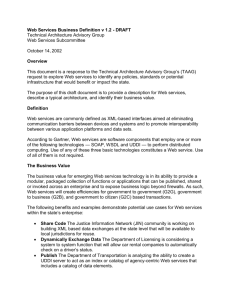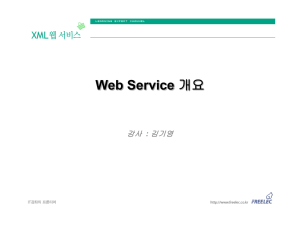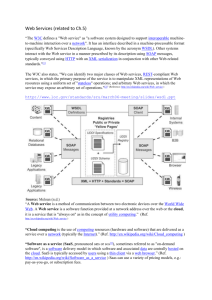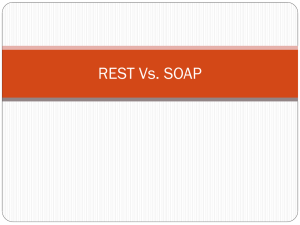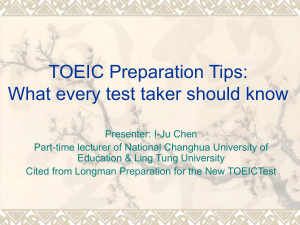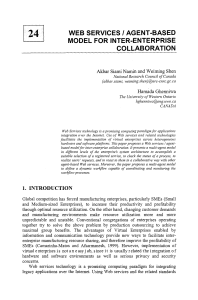Our initial focus was on standards for Business-to-Business
advertisement
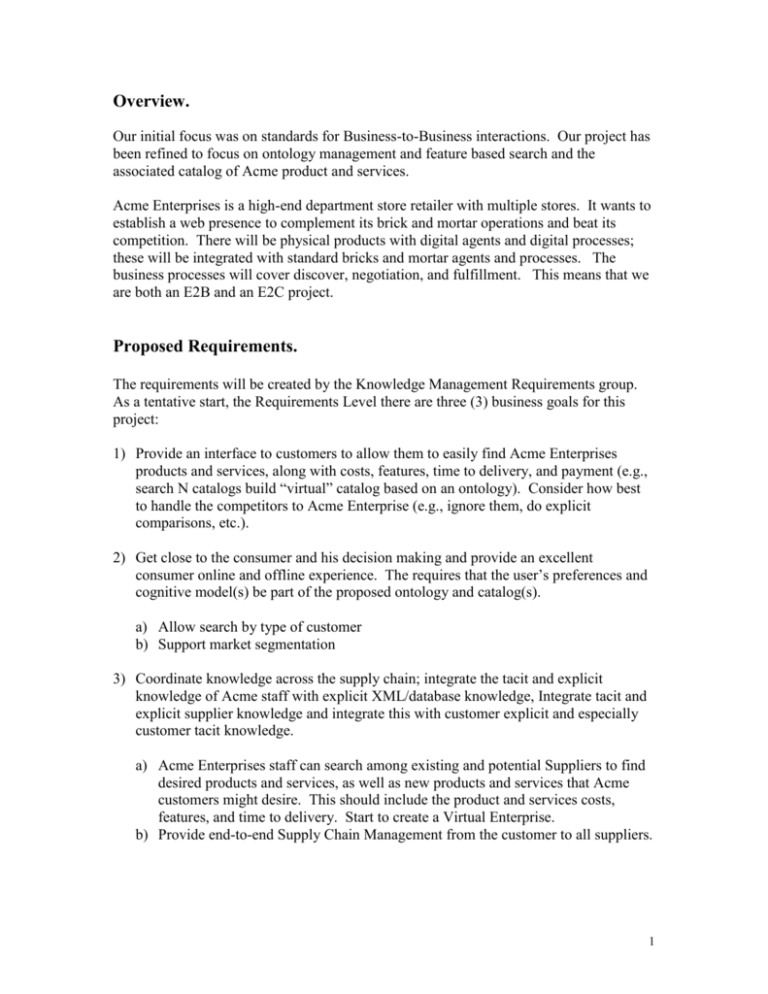
Overview. Our initial focus was on standards for Business-to-Business interactions. Our project has been refined to focus on ontology management and feature based search and the associated catalog of Acme product and services. Acme Enterprises is a high-end department store retailer with multiple stores. It wants to establish a web presence to complement its brick and mortar operations and beat its competition. There will be physical products with digital agents and digital processes; these will be integrated with standard bricks and mortar agents and processes. The business processes will cover discover, negotiation, and fulfillment. This means that we are both an E2B and an E2C project. Proposed Requirements. The requirements will be created by the Knowledge Management Requirements group. As a tentative start, the Requirements Level there are three (3) business goals for this project: 1) Provide an interface to customers to allow them to easily find Acme Enterprises products and services, along with costs, features, time to delivery, and payment (e.g., search N catalogs build “virtual” catalog based on an ontology). Consider how best to handle the competitors to Acme Enterprise (e.g., ignore them, do explicit comparisons, etc.). 2) Get close to the consumer and his decision making and provide an excellent consumer online and offline experience. The requires that the user’s preferences and cognitive model(s) be part of the proposed ontology and catalog(s). a) Allow search by type of customer b) Support market segmentation 3) Coordinate knowledge across the supply chain; integrate the tacit and explicit knowledge of Acme staff with explicit XML/database knowledge, Integrate tacit and explicit supplier knowledge and integrate this with customer explicit and especially customer tacit knowledge. a) Acme Enterprises staff can search among existing and potential Suppliers to find desired products and services, as well as new products and services that Acme customers might desire. This should include the product and services costs, features, and time to delivery. Start to create a Virtual Enterprise. b) Provide end-to-end Supply Chain Management from the customer to all suppliers. 1 Proposed Design. The central idea is to add semantic information to the Acme Enterprise and potential supplier product and service catalogs. There are a number of alternate emerging technologies to perform this function such as the Semantic Web, UDDI, RDF, WSDL, ebXML, BTP, and XML. The current focus is to evaluate the Universal Description, Discovery and Integration (UDDI) specifications. This allows for Search/Discovery support and the eventual creation of Electronic Markets. There is some overall between ebXML and UDDI. At the Design Level there are five proposed components, which are outlined in Figure One below. 1. 2. 3. 4. 5. Create a Relational Database to implement product and service catalogs for existing and potential suppliers, and each of the Acme Enterprise store sites. Build a mapping from the normalized relational schema to ebXML descriptions of both the Acme Enterprise and Supplier products and services. Use SOAP to package XML data and exchange it across system boundaries Create an Ontology to describe the catalog products and services, ideally this ontology will also describe all the UDDI based products and services from both suppliers and Acme Enterprises. Consider the use of WordNet. Create UDDI business, service, binding and service specification information (based on catalogs) to integrate the needed knowledge across Suppliers, Acme Enterprises and the Customers. Explore the potential overlaps and use of alternate standards such as ebXML, WSDL, etc. UDDI SOAP XML Internet Acme Store A UDDI SOAP XML Internet UDDI SOAP XML Internet Acme Store B Internet Supplier A UDDI SOAP XML Internet UDDI SOAP XML Internet Supplier B Figure One. Draft Ontology/Catalog Configuration 2 Implementation. The implementation issues follow the need to interface the five Design components. The expectation is that the tools that can link the relational database to XML will drive how all the other interfaces will be implemented. We need the following software development tools to integrate the design components. 1. 2. 3. 4. Map the Relational Databases to XML (e.g., FrontPage, ASP, CGI, PHP, ColdFusion, DreamWeaver) Map the XML to SOAP Packaging Map the Ontology to UDDI, XML, and perhaps the Relational Database attributes Provide a User Interface to the Ontology that allows access to distributed UDDI schema, XML, and underlying catalogs. Open Questions. 1. Requirements Question: Will department stores fall victim to reverse markets or can they become an infomediary? 2. Requirements Question: Do we want to know about competitors and their catalogs, if only for competitive reasons. 3. Requirements Question: Do we have to consider Mobile Commerce 4. Requirements & Design Questions: Should the ontology deal with the customer preferences and purchasing patterns? 5. Class Question: Should we pass our proposed requirements to the requirements group and then get the final requirements from them? 6. Class Question: Should we develop a catalog or depend on another group for its definition 7. Implementation Question: What technology should we use at the Semantic Level to create an Electronic Market (e.g., UDDI, ebXML, WSDL, etc.)? 8. Implementation Question: Do we have the time and software to explicitly use UDDI and SOAP in our project? 3

